Intrinsic Explainable Self-Enforcing Networks Using the ICON-D2-Ensemble Prediction System for Runway Configurations †
Abstract
1. Introduction
2. Methods
2.1. ICON-D2-EPS
2.2. Self-Enforcing Network (SEN)
2.3. Shapley Values
3. Model and Results
4. Conclusions and Recent Work
- It is necessary to build tools to view raw data in an aggregated and easily perceivable manner.
- It is necessary to move the experimentation software away from a desktop application and towards a command-line tool that can be executed on a HPC. Techniques and optimizations have to be introduced to deal with the new dimension of data.
- The modeling process can no longer be accomplished by a human alone but instead needs to be computer-aided in terms of data selection for the training process and validation of the resulting model.
- When discussing the results with domain experts, i.e., air traffic controllers, the decisions taken by the system must be retraceable and must be presented to them in a manner that makes it clear how the predicted result came about.
Author Contributions
Funding
Institutional Review Board Statement
Informed Consent Statement
Data Availability Statement
Conflicts of Interest
References
- Patriarca, R.; Simone, F.; Di Gravio, G. Supporting weather forecasting performance management at aerodromes through anomaly detection and hierarchical clustering. Expert Syst. Appl. 2023, 213, 119210. [Google Scholar] [CrossRef]
- Jones, J.C.; Ellenbogen, Z.; Glina, Y. Recommending strategic air traffic management initiatives in convective weather. J. Air Transp. 2023, 31, 45–56. [Google Scholar] [CrossRef]
- Scala, P.; Mota, M.M.; Ma, J.; Delahaye, D. Tackling uncertainty for the development of efficient decision support system in air traffic management. IEEE Trans. Intell. Transp. Syst. 2019, 21, 3233–3246. [Google Scholar] [CrossRef]
- Bombelli, A.; Sallan, J.M. Analysis of the effect of extreme weather on the US domestic air network. A delay and cancellation propagation network approach. J. Transp. Geogr. 2023, 107, 103541. [Google Scholar] [CrossRef]
- Khattak, A.; Chan, P.-W.; Chen, F.; Peng, H. Prediction of a Pilot’s Invisible Foe: The Severe Low-Level Wind Shear. Atmosphere 2023, 14, 37. [Google Scholar] [CrossRef]
- Zhang, L.; Min, J.; Zhuang, X.; Wang, S.; Qiao, X. The Lateral Boundary Perturbations Growth and Their Dependence on the Forcing Types of Severe Convection in Convection-Allowing Ensemble Forecasts. Atmosphere 2023, 14, 176. [Google Scholar] [CrossRef]
- Yiu, C.Y.; Ng, K.K.H.; Li, X.; Zhang, X.; Li, Q.; Lam, H.S.; Chong, M.H. Towards safe and collaborative aerodrome operations: Assessing shared situational awareness for adverse weather detection with EEG-enabled Bayesian neural networks. Adv. Eng. Inform. 2022, 53, 101698. [Google Scholar] [CrossRef]
- Fathi, M.; Haghi Kashani, M.; Jameii, S.M.; Mahdipour, E. Big Data Analytics in Weather Forecasting: A Systematic Review. Arch. Comput. Methods Eng. 2022, 29, 1247–1275. [Google Scholar] [CrossRef]
- Gonzalo, J.; Domínguez, D.; López, D.; García-Gutiérrez, A. An analysis and enhanced proposal of atmospheric boundary layer wind modelling techniques for automation of air traffic management. Chin. J. Aeronaut. 2021, 34, 129–144. [Google Scholar] [CrossRef]
- Li, Y.; Liu, Y.; Sun, R.; Guo, F.; Xu, X.; Xu, H. Convective Storm VIL and Lightning Nowcasting Using Satellite and Weather Radar Measurements Based on Multi-Task Learning Models. Adv. Atmos. Sci. 2023, 40, 887–899. [Google Scholar] [CrossRef]
- Benáček, P.; Farda, A.; Štěpánek, P. Postprocessing of Ensemble Weather Forecast Using Decision Tree–Based Probabilistic Forecasting Methods. Weather Forecast. 2023, 38, 69–82. [Google Scholar] [CrossRef]
- Takamatsu, T.; Ohtake, H.; Oozeki, T. Support Vector Quantile Regression for the Post-Processing of Meso-Scale Ensemble Prediction System Data in the Kanto Region: Solar Power Forecast Reducing Overestimation. Energies 2022, 15, 1330. [Google Scholar] [CrossRef]
- Tang, J.; Liu, G.; Pan, Q. Review on artificial intelligence techniques for improving representative air traffic management capability. J. Syst. Eng. Electron. 2022, 33, 1123–1134. [Google Scholar] [CrossRef]
- Churchill, A.; Coupe, W.J.; Jung, Y.C. Predicting Arrival and Departure Runway Assignments with Machine Learning. In Proceedings of the 2021 AIAA AVIATION FORUM, Virtual, 2–6 August 2021. [Google Scholar] [CrossRef]
- Memarzadeh, M.; Puranik, T.G.; Battistini, J.; Kalyanam, K.M.; Ryan, W. Airport Runway Configuration Management with Offline Model-Free Reinforcement Learning. In Proceedings of the 2023 AIAA SCITECH Forum, National Harbor, MD, USA, 23–27 January 2023. [Google Scholar] [CrossRef]
- Venkatachalam, K.; Trojovský, P.; Pamucar, D.; Bacanin, N.; Simic, V. DWFH. An improved data-driven deep weather forecasting hybrid model using Transductive Long Short Term Memory (T-LSTM). Expert Syst. Appl. 2023, 213, 119270. [Google Scholar] [CrossRef]
- Tang, S.; Fang, Q.; Yang, Y.; Chen, J.; Cai, K. A Learning Estimation Approach for Arrival and Departure Capacity considering Weather Impact. In Proceedings of the 2022 IEEE/AIAA 41st Digital Avionics Systems Conference (DASC), Portsmouth, VA, USA, 18–22 September 2022. [Google Scholar] [CrossRef]
- Ren, X.; Li, X.; Ren, K.; Song, J.; Xu, Z.; Deng, K.; Wang, X. Deep Learning-Based Weather Prediction: A Survey. Big Data Res. 2021, 23, 100178. [Google Scholar] [CrossRef]
- Schultz, M.G.; Betancourt, C.; Gong, B.; Kleinert, F.; Langguth, M.; Leufen, L.H.; Mozaffari, A.; Stadtler, S. Can deep learning beat numerical weather prediction? Philos. Trans. R. Soc. A 2021, 379, 20200097. [Google Scholar] [CrossRef]
- Zouaidia, K.; Rais, M.S.; Ghanemi, S. Weather forecasting based on hybrid decomposition methods and adaptive deep learning strategy. Neural Comput. Appl. 2023, 35, 11109–11124. [Google Scholar] [CrossRef]
- Doan, Q.-V.; Kusaka, H.; Sato, T.; Chen, F. S-SOM v1. 0: A structural self-organizing map algorithm for weather typing. Geosci. Model Dev. 2021, 14, 2097–2111. [Google Scholar] [CrossRef]
- Carvalho-Oliveira, J.; Borchert, L.F.; Zorita, E.; Baehr, J. Self-organizing maps identify windows of opportunity for seasonal European summer predictions. Front. Clim. 2022, 4, 844634. [Google Scholar] [CrossRef]
- Vilibić, I.; Šepić, J.; Mihanović, H.; Kalinić, H.; Cosoli, S.; Janeković, I.; Žagar, N.; Jesenko, B.; Tudor, M.; Dadić, V.; et al. Self-Organizing Maps-based ocean currents forecasting system. Sci. Rep. 2016, 6, 22924. [Google Scholar] [CrossRef]
- Czibula, G.; Mihai, A.; Mihuleţ, E.; Teodorovici, D. Using self-organizing maps for unsupervised analysis of radar data for nowcasting purposes. Procedia Comput. Sci. 2019, 159, 48–57. [Google Scholar] [CrossRef]
- Midtfjord, A.D.; De Bin, R.; Huseby, A.B. A decision support system for safer airplane landings: Predicting runway conditions using XGBoost and explainable AI. Cold Reg. Sci. Technol. 2022, 199, 103556. [Google Scholar] [CrossRef]
- Rudd, K.; Eshow, M.; Gibbs, M. Method for Generating Explainable Deep Learning Models in the Context of Air Traffic Management. In Proceedings of the Machine Learning, Optimization, and Data Science: 7th International Conference, LOD 2021, Grasmere, UK, 4–8 October 2021. Revised Selected Papers, Part I; 2022. [Google Scholar] [CrossRef]
- Xie, Y.; Pongsakornsathien, N.; Gardi, A.; Sabatini, R. Explanation of machine-learning solutions in air-traffic management. Aerospace 2021, 8, 224. [Google Scholar] [CrossRef]
- Degas, A.; Islam, M.R.; Hurter, C.; Barua, S.; Rahman, H.; Poudel, M.; Ruscio, D.; Ahmed, M.U.; Begum, S.; Rahman, A.; et al. A survey on artificial intelligence (ai) and explainable ai in air traffic management: Current trends and development with future research trajectory. Appl. Sci. 2022, 12, 1295. [Google Scholar] [CrossRef]
- Schwalbe, G.; Finzel, B. A comprehensive taxonomy for explainable artificial intelligence: A systematic survey of surveys on methods and concepts. Data Min. Knowl. Discov. 2023. [Google Scholar] [CrossRef]
- Arrieta, A.B.; Díaz-Rodríguez, N.; Del Ser, J.; Bennetot, A.; Tabik, S.; Barbado, A.; García, S.; Gil-Lopez, S.; Molina, D.; Benjamins, R.; et al. Explainable Artificial Intelligence (XAI): Concepts, taxonomies, opportunities and challenges toward responsible AI. Inf. Fusion 2020, 58, 82–115. [Google Scholar] [CrossRef]
- Greisbach, A.; Klüver, C. Determining Feature Importance in Self-Enforcing Networks to achieve Explainable AI (xAI). In Proceedings 32. Workshop Computational Intelligence; Schulte, H., Hoffmann, F., Mikut, R., Eds.; KIT Scientific Publishing: Karlsruhe, Germany, 2022; pp. 237–256. [Google Scholar]
- Reinert, D.; Prill, F.; Frank, H.; Denhard, M.; Baldauf, M.; Schraff, C.; Gebhardt, C.; Marsigli, C.; Zängl, G. DWD Database Reference for the Global and Regional ICON and ICON-EPS Forecasting System. 2023. Available online: https://www.dwd.de/SharedDocs/downloads/DE/modelldokumentationen/nwv/icon_d2/icon_d2_dbbeschr_aktuell.pdf?view=nasPublication&nn=13934 (accessed on 27 June 2023).
- Klüver, C.; Klüver, J.; Zinkhan, D. A self-enforcing neural network as decision support system for air traffic control based on probabilistic weather forecasts. In Proceedings of the IEEE International Joint Conference on Neural Networks (IJCNN), Anchorage, AK, USA, 14–19 May 2017; pp. 729–736. [Google Scholar] [CrossRef]
- Klüver, C.; Klüver, J. Self-organized learning by self-enforcing networks. In IWANN 2013, LNCS 7902; Part I; Rojas, I., Joya, G., Cabestany, J., Eds.; Springer: Berlin/Heidelberg, Germany, 2013; pp. 518–529. [Google Scholar] [CrossRef]
- Zinkhan, D.; Eiermann, S.; Klüver, C.; Klüver, J. Decision Support Systems for Air Traffic Control with Self-enforcing Networks Based on Weather Forecast and Reference Types for the Direction of Operation. In Advances in Computational Intelligence; IWANN 2021. Lecture Notes in Computer Science; Rojas, I., Joya, G., Catala, A., Eds.; Springer: Cham, Switzerland, 2021; Volume 12862, pp. 404–415. [Google Scholar] [CrossRef]
- Shapley, L.S. A Value for n-Person Games. In Contributions to the Theory of Games (AM-28); Kuhn, H.W., Tucker, A.W., Eds.; Princeton University Press: Princeton, NJ, USA, 1953; Volume 2, pp. 307–318. [Google Scholar]
- Rozemberczki, B.; Watson, L.; Bayer, P.; Yang, H.-T.; Kiss, O.; Nilsson, S.; Sarkar, R. The shapley value in machine learning. arXiv 2022, arXiv:2202.05594. [Google Scholar]
- Bokati, L.; Kosheleva, O.; Kreinovich, V.; Thach, N.N. Why Shapley Value and Its Variants Are Useful in Machine Learning (and in Other Applications). Proc., 15. Workshop Computational Intelligence. Departmental Technical Reports (CS). 1729. 2022. Available online: https://scholarworks.utep.edu/cs_techrep/1729/ (accessed on 27 June 2023).
- Casajus, A.; Huettner, F. Null, nullifying, or dummifying players: The difference between the Shapley value, the equal division value, and the equal surplus division value. Econ. Lett. 2014, 122, 167–169. [Google Scholar] [CrossRef]
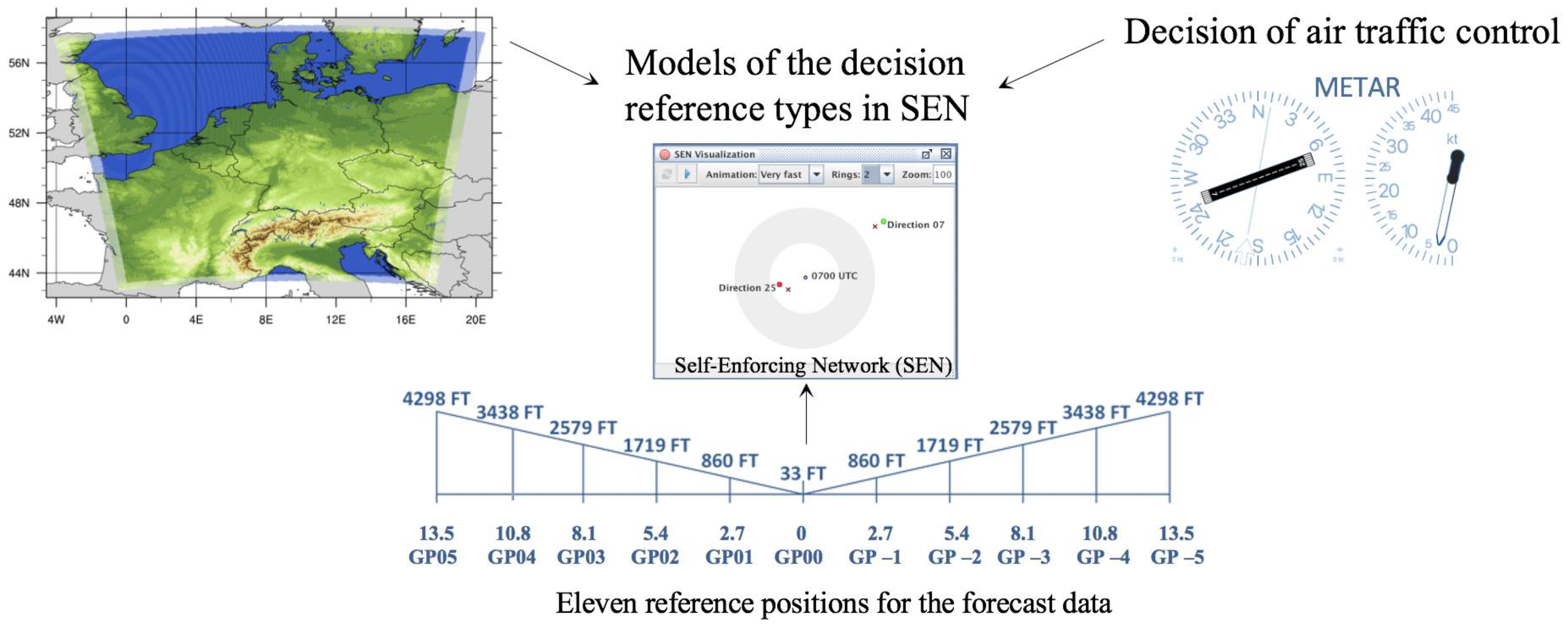

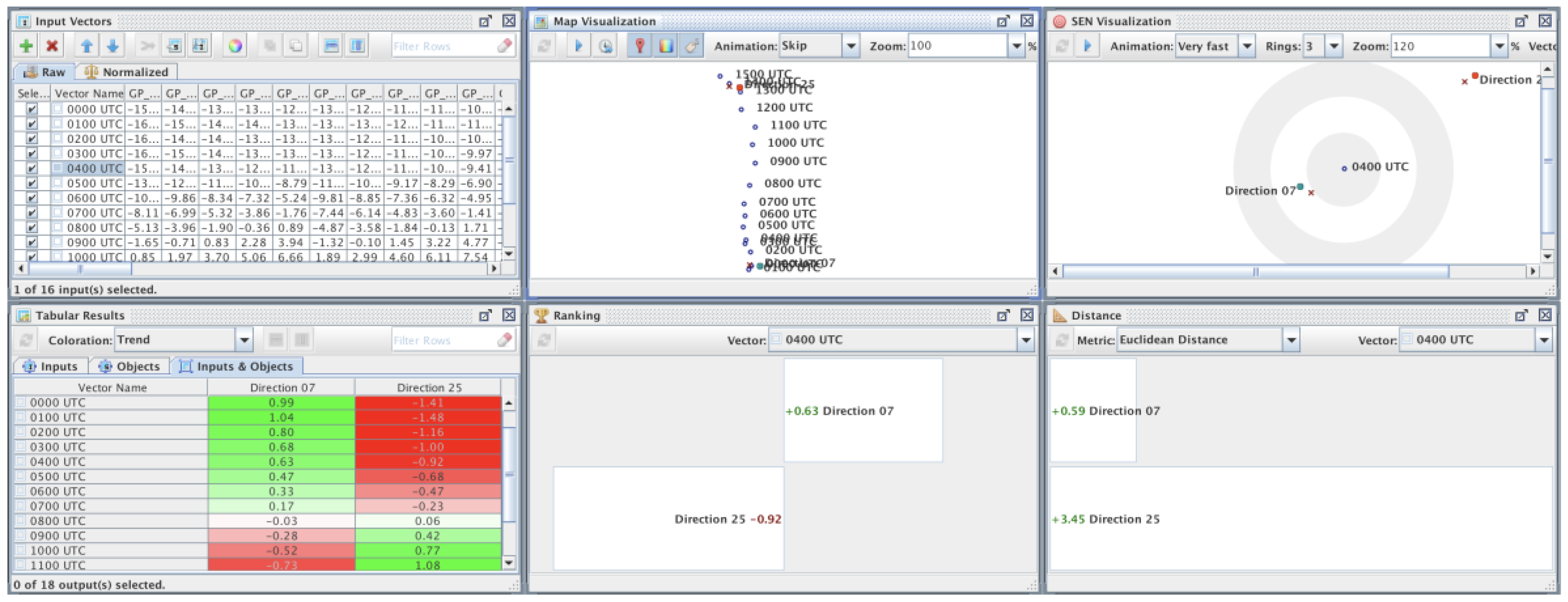
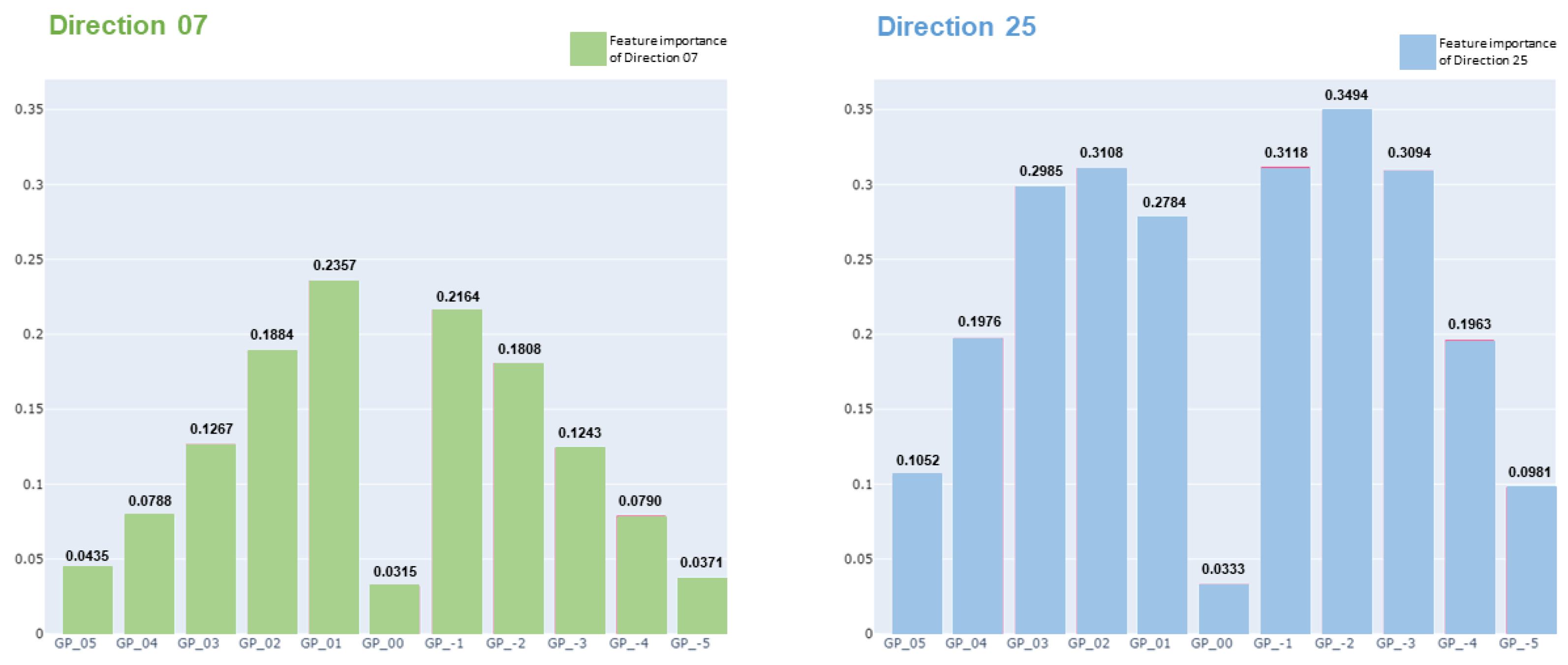
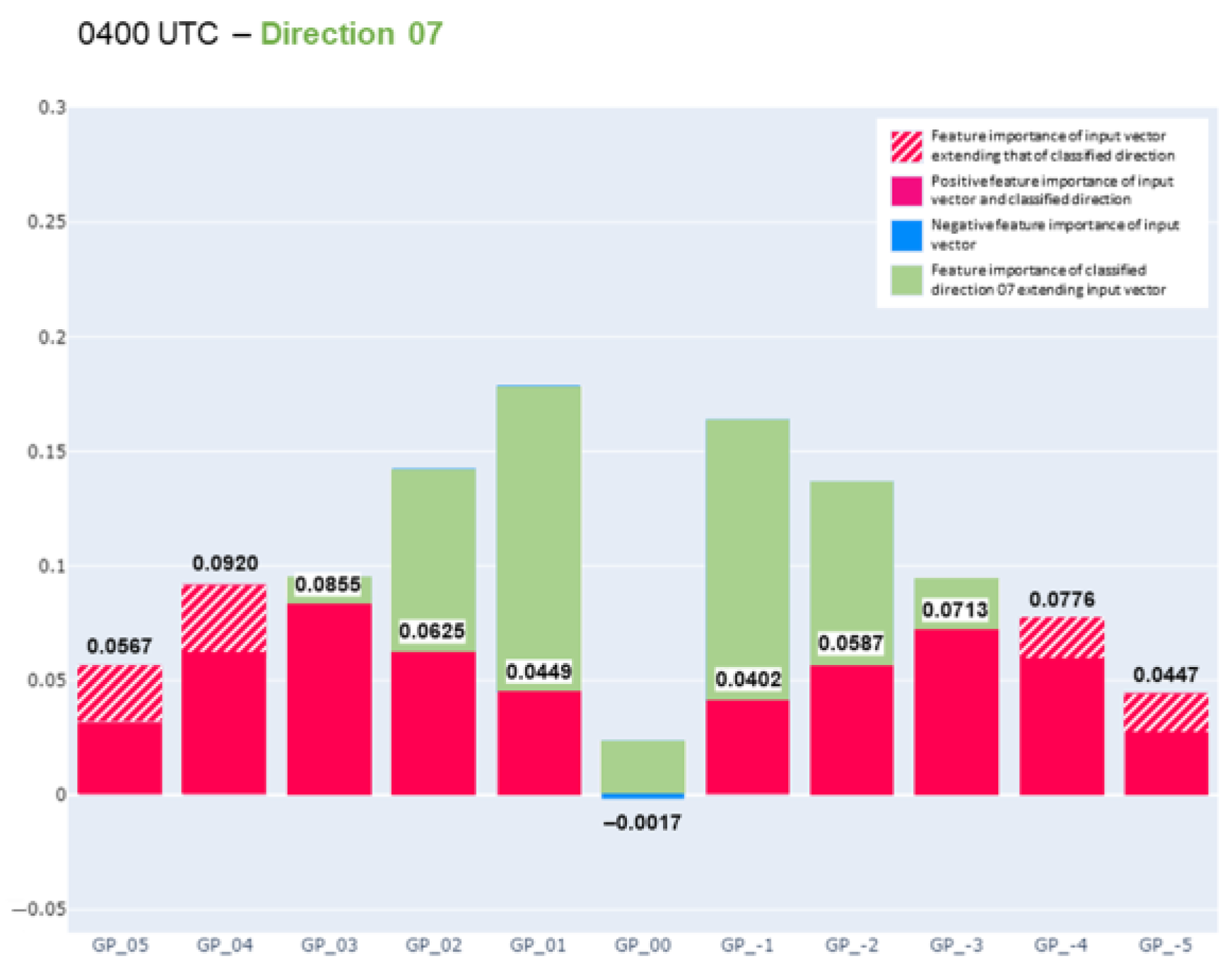



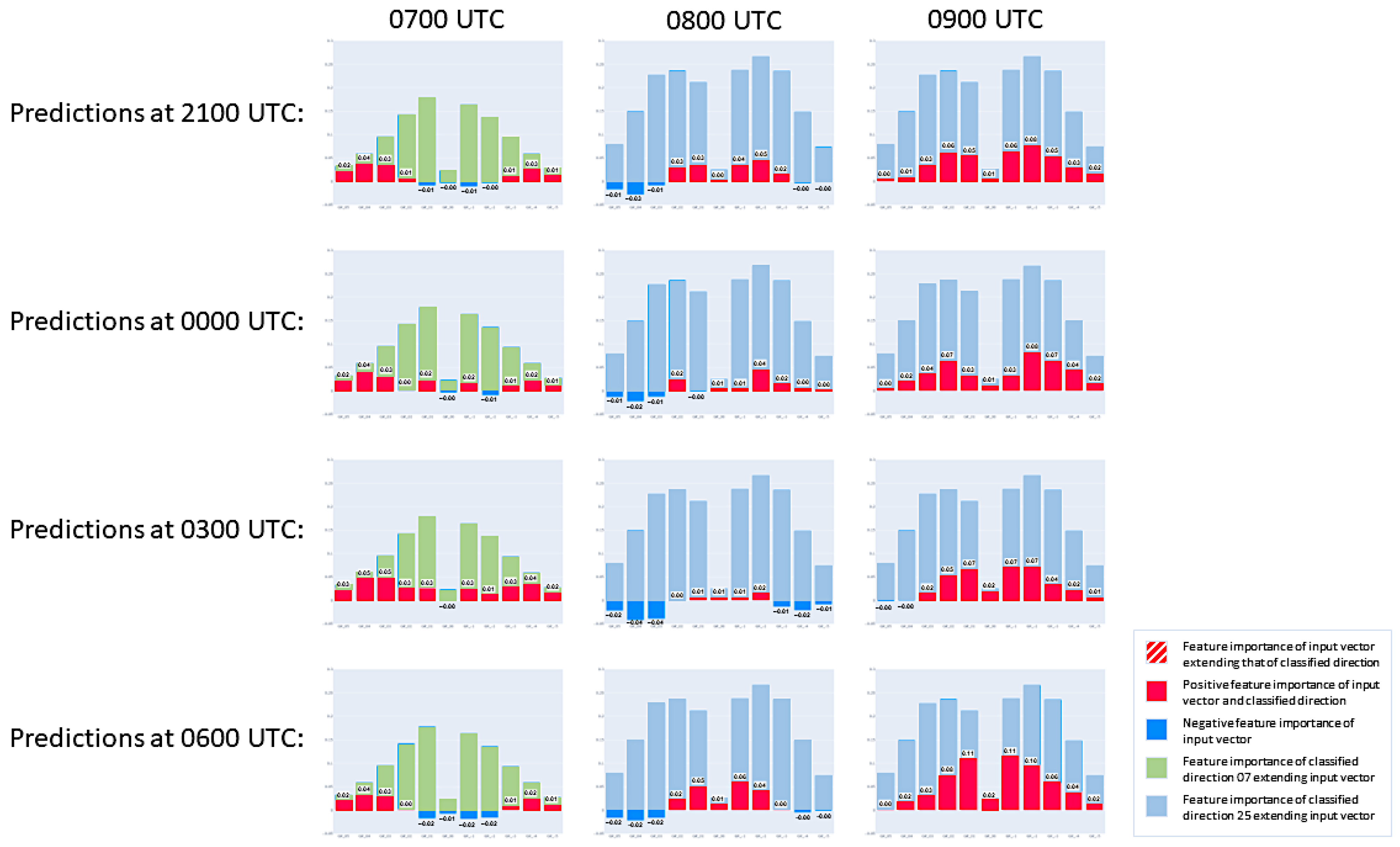
Disclaimer/Publisher’s Note: The statements, opinions and data contained in all publications are solely those of the individual author(s) and contributor(s) and not of MDPI and/or the editor(s). MDPI and/or the editor(s) disclaim responsibility for any injury to people or property resulting from any ideas, methods, instructions or products referred to in the content. |
© 2023 by the authors. Licensee MDPI, Basel, Switzerland. This article is an open access article distributed under the terms and conditions of the Creative Commons Attribution (CC BY) license (https://creativecommons.org/licenses/by/4.0/).
Share and Cite
Zinkhan, D.; Greisbach, A.; Zurmaar, B.; Klüver, C.; Klüver, J. Intrinsic Explainable Self-Enforcing Networks Using the ICON-D2-Ensemble Prediction System for Runway Configurations. Eng. Proc. 2023, 39, 41. https://doi.org/10.3390/engproc2023039041
Zinkhan D, Greisbach A, Zurmaar B, Klüver C, Klüver J. Intrinsic Explainable Self-Enforcing Networks Using the ICON-D2-Ensemble Prediction System for Runway Configurations. Engineering Proceedings. 2023; 39(1):41. https://doi.org/10.3390/engproc2023039041
Chicago/Turabian StyleZinkhan, Dirk, Anneliesa Greisbach, Björn Zurmaar, Christina Klüver, and Jürgen Klüver. 2023. "Intrinsic Explainable Self-Enforcing Networks Using the ICON-D2-Ensemble Prediction System for Runway Configurations" Engineering Proceedings 39, no. 1: 41. https://doi.org/10.3390/engproc2023039041
APA StyleZinkhan, D., Greisbach, A., Zurmaar, B., Klüver, C., & Klüver, J. (2023). Intrinsic Explainable Self-Enforcing Networks Using the ICON-D2-Ensemble Prediction System for Runway Configurations. Engineering Proceedings, 39(1), 41. https://doi.org/10.3390/engproc2023039041





